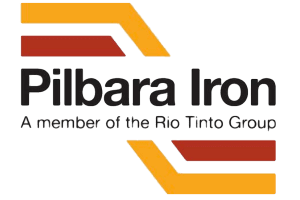
Pilbara Iron is a wholly owned subsidiary of the multinational Rio Tinto Group, that manages assets for Hamersley Iron Pty Ltd, a wholly owned subsidiary of Rio Tinto, and Robe River Iron Associates, an unincorporated joint venture between Rio and three Japanese steel companies Mitsui Iron Ore Development P/L (33%), Nippon Steel Australia P/L (10.5%) and Sumitomo Metal Australia P/L (3.5%).

Karijini National Park is an Australian national park centred in the Hamersley Ranges of the Pilbara region in the northwestern section of Western Australia. The park is located north of the Tropic of Capricorn, 1,055 kilometres (656 mi) from the state's capital city, Perth. Formerly known as Hamersley Range National Park, the park was officially renamed in 1991.

Iron ores are rocks and minerals from which metallic iron can be economically extracted. The ores are usually rich in iron oxides and vary in color from dark grey, bright yellow, or deep purple to rusty red. The iron is usually found in the form of magnetite (Fe
3O
4, 72.4% Fe), hematite (Fe
2O
3, 69.9% Fe), goethite (FeO(OH), 62.9% Fe), limonite (FeO(OH)·n(H2O), 55% Fe), or siderite (FeCO3, 48.2% Fe).
Kambalda type komatiitic nickel ore deposits are a class of magmatic iron-nickel-copper-platinum-group element ore deposit in which the physical processes of komatiite volcanology serve to deposit, concentrate and enrich a Fe-Ni-Cu-(PGE) sulfide melt within the lava flow environment of an erupting komatiite volcano.
Lateritic nickel ore deposits are surficial, weathered rinds formed on ultramafic rocks. They account for 73% of the continental world nickel resources and will be in the future the dominant source for the mining of nickel.

In the Earth sciences, a palaeochannel, also spelled paleochannel, is a significant length of a river or stream channel which no longer conveys fluvial discharge as part of an active fluvial system. The term palaeochannel is derived from the combination of two words, palaeo or old, and channel; i.e., a palaeochannel is an old channel. Palaeochannels may be preserved either as abandoned surface channels on the surface of river floodplains and terraces or infilled and partially or fully buried by younger sediments. The fill of a palaeochannel and its enclosing sedimentary deposits may consist of unconsolidated, semi-consolidated, or well-cemented sedimentary strata depending on the action of tectonics and diagenesis during their geologic history after deposition. The abandonment of an active fluvial channel and the resulting formation of a palaeochannel can be the result of tectonic processes, geomorphologic processes, anthropogenic activities, climatic changes, or a variable and interrelated combination of these factors.

The Hamersley & Robe River railway, majority-owned by Rio Tinto, and operated by its subsidiary Pilbara Iron, is a private rail network in the Pilbara region of Western Australia for the purpose of carrying iron ore. The network is larger than any other Australian heavy freight rail network in private ownership. The total length of its track is about 1,700 km (1,056 mi).

The Fortescue railway, owned and operated by Fortescue Metals Group (FMG), is a private rail network in the Pilbara region of Western Australia built to carry iron ore. It opened in 2008. When it was completed, it was the heaviest haul railway in the world, designed for 40 tonne axle loads, 2.5 to 5 tonnes heavier than the other Pilbara iron ore rail systems. On 4 November 2014, FMG Rail commenced trialling 42-tonne axle loads.
The Nammuldi mine is an iron ore mine located in the Pilbara region of Western Australia, 60 kilometres north-west of Tom Price.

The Mount Tom Price mine is an iron ore mine located in the Pilbara region of Western Australia, near the town of Tom Price.
The Marandoo mine is an iron ore mine located in the Pilbara region of Western Australia, 45 kilometres east of Tom Price.
The Mesa A mine, sometimes also referred to as Waramboo mine, is an iron ore mine located in the Pilbara region of Western Australia, 50 km (31 mi) west of Pannawonica.
The Mesa J mine is an iron ore mine located in the Pilbara region of Western Australia, 16 kilometres south-west of Pannawonica.

The Paraburdoo mine is an iron ore mine located in the Pilbara region of Western Australia, near Paraburdoo.
The Channar mine is an iron ore mine located in the Pilbara region of Western Australia, 17 kilometres south-east of Paraburdoo.
The Eastern Range mine is an iron ore mine in the Pilbara region of Western Australia, 10 kilometres south-east of Paraburdoo.

The West Angelas mine is an iron ore mine located in the Pilbara region of Western Australia, 110 kilometres North West of Newman.
The Yandicoogina mine, often shortened to Yandi, is an iron ore mine located in the Pilbara region of Western Australia, 95 kilometres north-west of Newman. it should not be confused with BHP Billiton's Yandi mine, which is located nearby.
The Hope Downs mine is an iron ore mining complex located in the Pilbara region of Western Australia. It comprises four large open-pit mines. The mines are co-owned by the Hancock Group and Rio Tinto, and the complex was named after Hope Hancock.
The Railways in the Pilbara are a collection of railways in the Pilbara region of north-west Western Australia.








